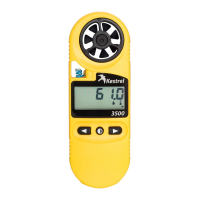for 2 seconds to manually turn o the unit. The unit will automatically
turn o if no buttons have been pressed for 45 minutes.
UNDERSTANDING THE MEASUREMENTS
Wind Speed - average over the previous three seconds. The measurement will be accurate
for air ow through the front or rear of the unit.
Maximum Wind Gust - maximum 3 - second wind speed since the unit was turned on.
Average Wind Speed - average wind speed since the unit was turned on.
Temperature - instantaneous temperature of the thermistor, which is located at the end
of the long coiled leads in the open cavity below the impeller. The exposed thermistor will
respond quickly to changes in temperature when air ows past it. For fastest response, either
hold the unit into the wind or wave the unit side to side for 15 seconds. Readings should be
taken in the shade. Water and snow temperatures can be taken by hold the unit in the water
or snow.
Wind Chill - combination of wind speed and temperature, as dened by the US National
Weather Service. Wind chill is the eective temperature on a human or animal at low
temperatures due to wind speed. Wind chill readings will be the same as the temperature
readings above 45ºF or below 3 mph.
Relative Humidity - amount of moisture in the air compared to the amount of moisture the
air can hold for the given temperature, represented as a percent. Because relative humidity is
also a function of the temperature, the response time will be dependent on the temperature
response time (see temperature section above). Readings should be taken in the shade.
Heat Stress – combination of temperature and humidity, as dened by the US National
Weather Service. Heat stress is the eective temperature on a human or animal at high
temperatures due to humidity. Heat stress readings will be the same as the temperature
readings below 70ºF.
Dewpoint – calculated based on temperature and humidity measurements, as a measure of
moisture content in the air. If the dewpoint is very close to the temperature, the air is humid.
If the temperature and dewpoint are the same, dew will form. If this happens below freezing,
frost will form.
Wet Bulb Temperature - calculated based on temperature and humidity measurements, as a
measure of evaporation rate. If the wet bulb temperature is very close to the air temperature,
the air is humid. Wet bulb temperature is typically measured by swinging a mercury
thermometer with a wet sock on its end for several minutes.

